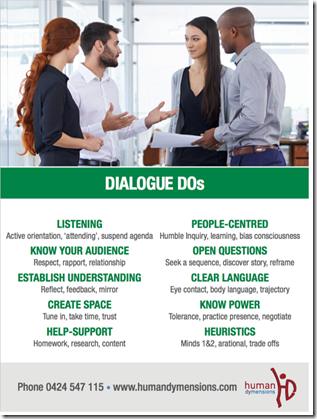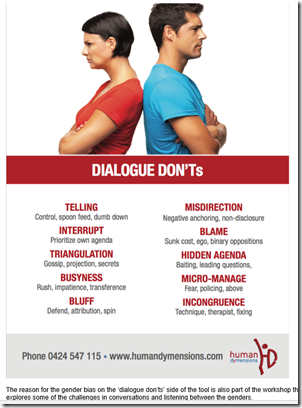The challenge with effectiveness in conversations is disposition. How are you pre-disposed to the ‘other’ in approach, listening, reflecting and responding? Yes, skill development and technique are important but these are easier learned than getting one’s disposition right.
You would think people would know how to walk about site, engage with others, build rapport and ‘help’ others in their work but this doesn’t seem to be so. Indeed, whenever I use the SPoR iCue HSE Audit tool the idea of ‘helping’ rarely surfaces. The most common responses in the Audit about engagement is about ‘telling’, ‘controlling’ and ‘fixing’. It seems that the job of a safety person is to be the fount of all knowledge, walk around site and correct poor behaviour. The ideas of ‘helping’, ‘facilitating’ and ‘empowering’ others just never comes out in the diagnostic.
If one goes out on a site walk and seeks to ‘control’ others, don’t go out. All this does is create a workplace that can’t only think critically about risk when the safety person is about. A sure recipe for safety person exhaustion. If the object of site walks is learning, listening, discovery and helping, then go out and have conversations. Regardless of technique, you are likely to be effective.
The fundamentals of open questioning are not rocket science but even then it’s also often in the way the same question is being asked. Simple starters like ‘can you tell me about?’ or ‘can you step me through what you are doing?’ are effective if the worker senses that you are there to listen, not interrupt and not come back with a ‘telling’ ‘control’. Safety is not about the transfer of knowledge but rather the transfer of empathy. The safety person is not doing the job, doesn’t know the job in minute detail and doesn’t need to know the minute detail. Above all else, the safety person needs to be a listener a helper.
When we run our one day Conversations Skill Workshops (https://www.humandymensions.com/services-and-programs/mirisc-workshop/) it is clear that many people in the safety industry have not received basic coaching in conversations skills. Many have not been given opportunity to practice and be observed in they way they converse with others about risk. If we do a follow up workshop we develop skills further through micro-training/teaching, a special technique where conversations are recorded and where people later view themselves and offer their own criticism, we are often our own worst critic. The role of the facilitator is not to criticise the recording but to rather support the things done well and raise areas for improvement. I have been doing this micro-training/teaching process for over 30 years in various settings and it takes some careful managing to be effective.
Micro-teaching/training emerged in the 1970s associated with teacher training (see: Pfeiffer and Jones, (1970) a handbook of structured experiences for human relations training). It continues to be used in many professions that require helping, educating, coaching and personal engagement skills (https://www.mitraining.edu.au/categories/micro-training/ ). When I undertook teacher training in 1970-73 we were recorded in education settings each month for several years and would watch ourselves for the purpose of improvement and learning. For some reason it always was scheduled for last thing on a Friday. Perhaps they knew we could leave and happy up over a beer after?
Micro-training/teaching techniques are initially threatening and somewhat embarrassing but once one gets desensitised to the process can prove a highly effective for improving skills in relationship development. Such training is common in the teaching profession, nursing, legal practice, clergy, social work and medicine (https://www.researchgate.net/publication/271106745_Micro_Teaching_to_Improve_Teaching_Method_An_Analysis_on_Students’_Perspectives ; https://www.researchgate.net/publication/330889488_Teaching_How_to_Teach_Microteaching_A_Way_to_Build_up_Teaching_Skills ; https://www.ncbi.nlm.nih.gov/pmc/articles/PMC3724377/ ). Indeed, micro-teaching/training is foundational for any helping profession. One would expect any activity that needs to have effective relationships, conversations and engagement would already be undertaking such a process in any diploma/degree.
There is endless research on the importance of relationships in the helping professions indeed, people even get well quicker if they have confidence in their doctor as perceived though the doctor’s bedside manner (https://www.researchgate.net/publication/289736876_Bedside_manner_Concept_analysis_and_impact_on_advanced_nursing_practice ). Similarly, nurses need to have effective relationships skills too because often what they do can be painful for the patient just as dentists need such a foundation for effectiveness. We are willing and more able to cope with that needle in a painful place if we trust and like the one administering it (https://s3-eu-west-1.amazonaws.com/content.gresham.ac.uk/data/binary/2656/2018-02-14_MartinElliott_GoodBedsideManner-T.pdf). Even if the needle hurts, the likeability I have for the professional administering it and my perception of their compassion and helpfulness makes the pain easier to accept.
‘Helping’ is not ‘controlling’ or ‘telling’ and is founded on a disposition that knows that lessons that are ‘owned’ and ‘discovered’ are a hundred times more effective than telling and controlling. The idea of being a ‘Skilled Helper’ (see Egan (1998) https://www.researchgate.net/publication/337084700_Egan’s_Skilled_Helper_Model) is 101 in pastoral care and all incident investigations. Schein also provides a very clear and structured process for how to be a helping professional (Schein, 1999) Process Consultation Revisted, Building the Helping Relationship). What a shame that the safety industry doesn’t have this focus in its curriculum or its body of knowledge. Just imagine what kind of safety people there would be in the field in incident investigations and safety improvement if safety people understood themselves as helpers. What a shame that the safety industry (according to all the diagnostic assessment I have done through the SPoR iCue HSE Audit and MiProfile) understands itself as ‘tellers’, ‘controllers’ and ‘fixers’.
As part of our Observations-Conversations Workshop we hand out a number of tools to help improve conversations, one of these is the Dialogue Do and Don’t Tool. (None of our workshops increase paperwork but all focus like this on practical doable skills) This tool is just a simple set of skills that assist dialogue, relationships and mutual understanding. The tool is as follows:
The reason for the gender bias on the ‘dialogue don’ts’ side of the tool is also part of the workshop that explores some of the challenges in conversations and listening between the genders.
People need skill development in listening and conversation but also in observation, this involves being trained in what to look and listen for and these are not hazards. Hazard searches and lists are pretty useless, hazards don’t get fixed just because they are put in a list. When one knows how to observe cultural and psychological risk indicators (what we call iCues), then the conversations that follow are of great value. Improving observations skills would require some more discussion about semiotics- semiosis and perhaps that discussion is for another blog. One thing is for sure, a semiotic worldview changes how one ‘sees’ the world and what one envisions from that perception. Visual, spacial and risk intelligence should all merge together in an effective observation-conversation process.





Rob Long says
When any human being expects perfection from another human being, there has to be corruption. It doesn’t matter when or how but eventually it will come out as with DuPont. Zero is a delusional ideology based on the irrational denial of human fallibility, what could possibly go wrong? Ask DuPont?
Don says
Having taken Rob’s course work, I can tell you that the 1 brain 3 minds, and WHG added to ANY investigation automatically improves the quality and depth of what is learned. The hardest thing for me was to learn to keep asking open ended questions with a disposition of listening and learning. What i mean by that is the more one can keep the conversation going by asking open questions in the right way with a humble world view, the more layers will be revealed, which helps develop trust, which help uncover more of what is beneath the surface.
Until you have someone who understands the art of open questioning and risk Icues, it is easy to be mislead that we know how to ask questions in a way that will both uncover some of the hidden layers or risk and build relationships in a sustainable, balanced and compassionate way.
Rob Long says
Thanks Don. The strange thing is that such a simple disposition as not wanting to control something or another person is so hard to put into practice. The hardest part for safety people is needing to unlearn years of bad habits.
bernardcorden says
Many years ago during my Shell UK Oil days at a Stanlow Oil Managers Association (SOMA) training course at Shell Centre in London we were recorded during a communication skills session but the volume was not working on playback and just the body language was terrifying to watch.
Douglas Bader gave us a talk on leadership in the morning and I can vividly remember the session after lunch. The teacher was ex-military panjandrum and was even equipped a pointed stick.
A young electrical engineering technician seated beside me soon fell asleep and began snoring. The teacher boomed out with regimental authority ……”Corden, will you wake Jones up”.
I replied….”You put him asleep, you wake him up”.
Rob Long says
So true Beranrd. A teacher will spend 4 years learning about learning and teaching and how to present and still not get it right without the right disposition. Then Safety comes along and thinks presentation and teaching can be learned off the back of a postage stamp.
Pierre Joubert says
Good Morning Dr Rob i agree with you Observation is the best Tools in Safety P T O is also very Effective The Problem and challenges are that most Companies Management dont want to comply and this is a huge Problem for the Safety Officer. Al tough i am just keeping all my reports and E Mails if something will happen on site for proof that Management was informed old any unsafe Conditions and Acts